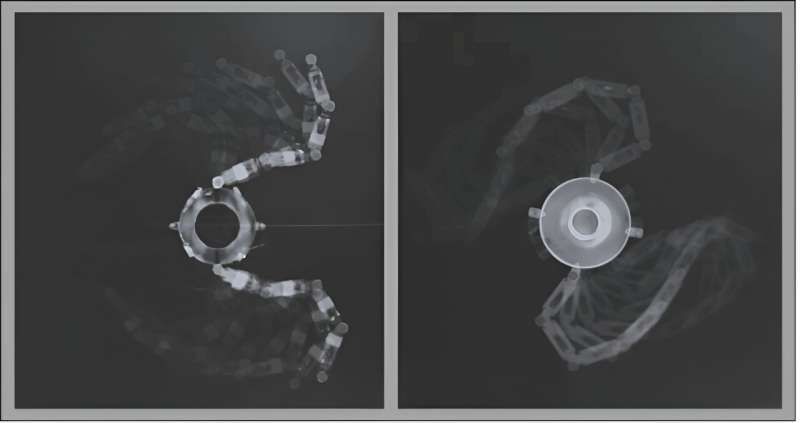
Cilia are sensory structures extending from the surface of some cells. These hair-like structures are known to contribute to the sensorimotor capabilities of various living organisms, including humans.
To serve their physiological functions, cilia must beat synchronously. While many past studies have set out to explore ciliary synchronization, its biological and mechanical underpinnings are not yet fully understood. This is partly because studying cilia in living samples and under controlled experimental conditions is difficult.
Researchers at the Institute of Physics of the Chinese Academy of Sciences recently introduced a new platform that could be used to reproduce the mechanics of cilia and study their behavior in a controlled setting. Their proposed system for modeling cilia, presented in a paper published in Physical Review Letters, consists of chains of self-propelling robots called HEXBUGs.
“This project came about after Yiming Xia and Zixian Hu constructed a chain of HEXBUG robots for fun, which were initially used to study the collective motion of self-propelling agents,” Mingcheng Yang, co-author of the paper, told Phys.org.
“Surprisingly, they found that two HEXBUG-chains anchored to a shared base can beat synchronously. We immediately realized that the anchored HEXBUG-chains behave similarly to biological cilia and could be used to study the synchronization between cilia that is exclusively induced by mechanical coupling (i.e., without hydrodynamic effects).”
Dr. Da Wei, co-author of the paper, is an expert on biological cilia and has been studying the synchronization of cilia in the biological model organism C. reinhardtii for some time. As part of this recent work, he assessed the potential of the robotic system for experimentally reproducing ciliary behavior.
“To understand the mechanic underpinning of the interesting dynamics of the anchored HEXBUG-chains, we constructed a reduced theoretical model based on connecting self-propelled particles,” Yang said. “Subsequently, Yiming Xia performed Brownian dynamics simulations in a wide range of the system parameters, successfully reproducing the experimental observations.”
The simulations run by Xia were used to model the competition and transition between different gaits in their system, while also accurately predicting its thermodynamics. This in turn could be used to explore the energetic rule that might govern the evolution of ciliary behaviors, particularly how different synchronous gaits compete and emerge energetically.
“After some attempts, we recognized that the present simple system evolved toward the steady state with the maximum energy dissipation (i.e., the maximum entropy production rate),” Yang said.
The model system created by this team of researchers consists of a series of micro-bots, known as HEXBUG robots, connected to each other to form chains. To connect the robots, the researchers used some caps that they had fabricated using 3D printing. The joints on these caps define the maximum angle at which adjacent HEXABUG robots can bend. This angle is what ultimately controls the waveform of the system’s produced ciliary beating motion.
After anchoring the two chains on the same base (resembling the algal cell body) and loading the base with different weights, Yang and his colleagues found that a stronger friction (a larger weight) hinders the chains’ ability to synchronize. In addition, they changed the source powering their artificial cilia-like system to an external DC supply. This allowed them to control the system’s effective driving force, which is associated with the voltage applied.
“These experimental systems are well modeled in the simulations,” Yang said. “HEXBUGS are abstracted as self-propelling rods, their mechanical interactions are captured by the connecting springs, and the friction of the base and the active driving force serve as two major control parameters. After systematically characterizing the simulation system and benchmark with experimental results, we were sure that the simulations captured the essence of the real setup.”
As part of their study, the team thus deployed their system in both simulations and experimental settings. The simulated system offered them vast possibilities for exploring their system’s parameter space, leading to detailed predictions about gait transitions and fundamental physics.
“The simulations enabled the computation of the energetics, which would be impossible to compute accurately via experiments,” Yang explained.
Yang and his colleagues successfully developed a controlled platform that can be used to study the mechanically mediated synchronization behaviors observed in cilia. In the future, their proposed system could be used by other researchers worldwide to further advance the understanding of cilia and their underlying physics, which is typically difficult to probe experimentally.
“This platform can be used to realize and study complex ciliary behavior in a controlled manner,” Yang said. “It could be helpful for biophysicists working on cilia synchronization to test their working hypothesis.”
For this specific system, the researchers found that among two possible states, it typically favors the more dissipative one. This suggests that at least the evolution of some non-equilibrium systems may be directed to the maximum energy dissipation.
“We believe this would be interesting for researchers that are seeking the general principle governing non-equilibrium systems,” Yang added.
“We are now working on an analytic model to help better explain mechanically connected ciliary beating behavior. Meanwhile, we are also looking at more complex scenarios such as synchronization among multiple cilia. Through these further investigations, we hope to figure out the necessary conditions under which a nonequilibrium steady-state system favors the state with stronger dissipation.”
More information:
Yiming Xia et al, Biomimetic Synchronization in Biciliated Robots, Physical Review Letters (2024). DOI: 10.1103/PhysRevLett.133.048302. On arXiv: DOI: 10.48550/arxiv.2312.15728
© 2024 Science X Network
Citation:
A new robotic platform to reproduce and study complex ciliary behavior (2024, August 13)
retrieved 13 August 2024
from https://phys.org/news/2024-08-robotic-platform-complex-ciliary-behavior.html
This document is subject to copyright. Apart from any fair dealing for the purpose of private study or research, no
part may be reproduced without the written permission. The content is provided for information purposes only.
